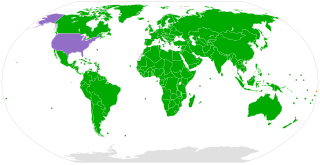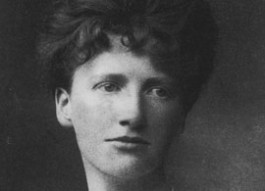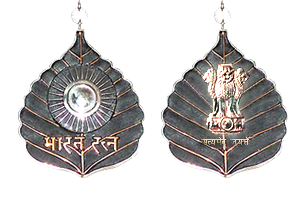
Extreme poverty is the most severe type of poverty, defined by the United Nations (UN) as "a condition characterized by severe deprivation of basic human needs, including food, safe drinking water, sanitation facilities, health, shelter, education and information. It depends not only on income but also on access to services". Historically, other definitions have been proposed within the United Nations.

The United Nations Convention on the Rights of the Child is an international human rights treaty which sets out the civil, political, economic, social, health and cultural rights of children. The convention defines a child as any human being under the age of eighteen, unless the age of majority is attained earlier under national legislation.
The Save the Children Fund, commonly known as Save the Children, is an international, non-government operated organization. It was founded in the UK in 1919, with the goal of helping improve the lives of children worldwide.
The Children's Rights Movement is a historical and modern movement committed to the acknowledgment, expansion, and/or regression of the rights of children around the world. This act laid several constitutional laws for the growth of a child's mental and physical health.. It began in the early part of the last century and has been an effort by government organizations, advocacy groups, academics, lawyers, lawmakers, and judges to construct a system of laws and policies that enhance and protect the lives of children. While the historical definition of child has varied, the United Nations Convention on the Rights of the Child asserts that "A child is any human being below the age of eighteen years, unless under the law applicable to the child, majority is attained earlier." There are no definitions of other terms used to describe young people such as "adolescents", "teenagers" or "youth" in international law.
Children's rights or the rights of children are a subset of human rights with particular attention to the rights of special protection and care afforded to minors. The 1989 Convention on the Rights of the Child (CRC) defines a child as "any human being below the age of eighteen years, unless under the law applicable to the child, majority is attained earlier." Children's rights includes their right to association with both parents, human identity as well as the basic needs for physical protection, food, universal state-paid education, health care, and criminal laws appropriate for the age and development of the child, equal protection of the child's civil rights, and freedom from discrimination on the basis of the child's race, gender, sexual orientation, gender identity, national origin, religion, disability, color, ethnicity, or other characteristics.
ActionAid is an international non-governmental organization whose stated primary aim is to work against poverty and injustice worldwide.
Save the Children Australia is an aid and development agency dedicated to helping children in Australia and overseas. It is an independent, not-for-profit and secular organisation.

Eglantyne Jebb was a British social reformer who founded the Save the Children organisation at the end of the First World War to relieve the effects of famine in Austria-Hungary and Germany. She drafted the document that became the Declaration of the Rights of the Child.

The Declaration of the Rights of the Child, sometimes known as the Geneva Declaration of the Rights of the Child, is an international document promoting child rights, drafted by Eglantyne Jebb and adopted by the League of Nations in 1924, and adopted in an extended form by the United Nations in 1959.

Plan International is a development and humanitarian organisation which works in over 75 countries across Africa, the Americas, and Asia to advance children’s rights and equality for girls. Its focus is on child protection, education, child participation, economic security, emergencies, health, sexual and reproductive health and rights, and water and sanitation. As of 2021, Plan International reached 26.2 million girls and 24.1 million boys through its programming.

The Indian honours system is the system of awards given to individuals for a variety of services to the Republic of India. The categories of awards are as follows:

Kailash Satyarthi is an Indian social reformer who campaigned against child labor in India and advocated the universal right to education.
Save the Children is a child-welfare non-profit organisations founded in London in 1919.

Child Rights and You (CRY) is an Indian non-governmental organization (NGO) that works towards ensuring children's rights.
UNICEF, originally called the United Nations International Children's Emergency Fund in full, now officially United Nations Children's Fund, is an agency of the United Nations responsible for providing humanitarian and developmental aid to children worldwide. The organization is one of the most widely known and visible social welfare entities globally, operating in 192 countries and territories. UNICEF's activities include providing immunizations and disease prevention, administering treatment for children and mothers with HIV, enhancing childhood and maternal nutrition, improving sanitation, promoting education, and providing emergency relief in response to disasters.
Vidyaben Shah was an Indian social worker and activist known for her work with children, women and the elderly in India. While she was already serving as Vice-President, she was appointed the first non-officio President of the New Delhi Municipal Council (NDMC) by Prime Minister Indira Gandhi in 1975. She has held several leading positions in the field of social welfare since the 1940s. Vidyaben Shah died at the age of 97 on 19 June 2020 at her residence in Delhi, her son Mihir Shah confirmed the news of Vidyaben Shah death.
Taiwan Fund for Children and Families is a nonprofit organization in Taiwan that provides services to vulnerable children and families, including children under 18 or college students still pursuing their education. “Livelihood Supports” and “Child Protection” are its two main target programs. Regardless of race, religion or gender, TFCF was established in 1950 and received assistance during its inception from China’s Children Fund (CCF), an NGO based in Virginia, United States. TFCF became independent in 1985. Currently, there are 24 branch offices, 11 affiliates, 3 nonprofit kindergartens as well as 7 overseas branch offices located in Mongolia, Kyrgyzstan, Kingdom of Eswatini, Vietnam, Cambodia, Jordan, and the Philippines. TFCF also engages in partnerships with organizations, including ChildFund International USA, Children Believe, ChildFund Australia, and PLAN BØRNEfonden to offer a children sponsorship program that aid more than 50,000 underprivileged children across 34 countries.

Nandan Jha is the chairman of Interactive Forum on Indian Economy not-for-profit company.

Anurag Chauhan is an Indian social worker and founder of Humans For Humanity, a non-governmental organization (NGO) headquartered in Dehradun, India He is widely known for social work, particularly with regards to menstrual hygiene. The WASH project started by him has reached over 3.5 million women in over 6 states in last 5 years.









